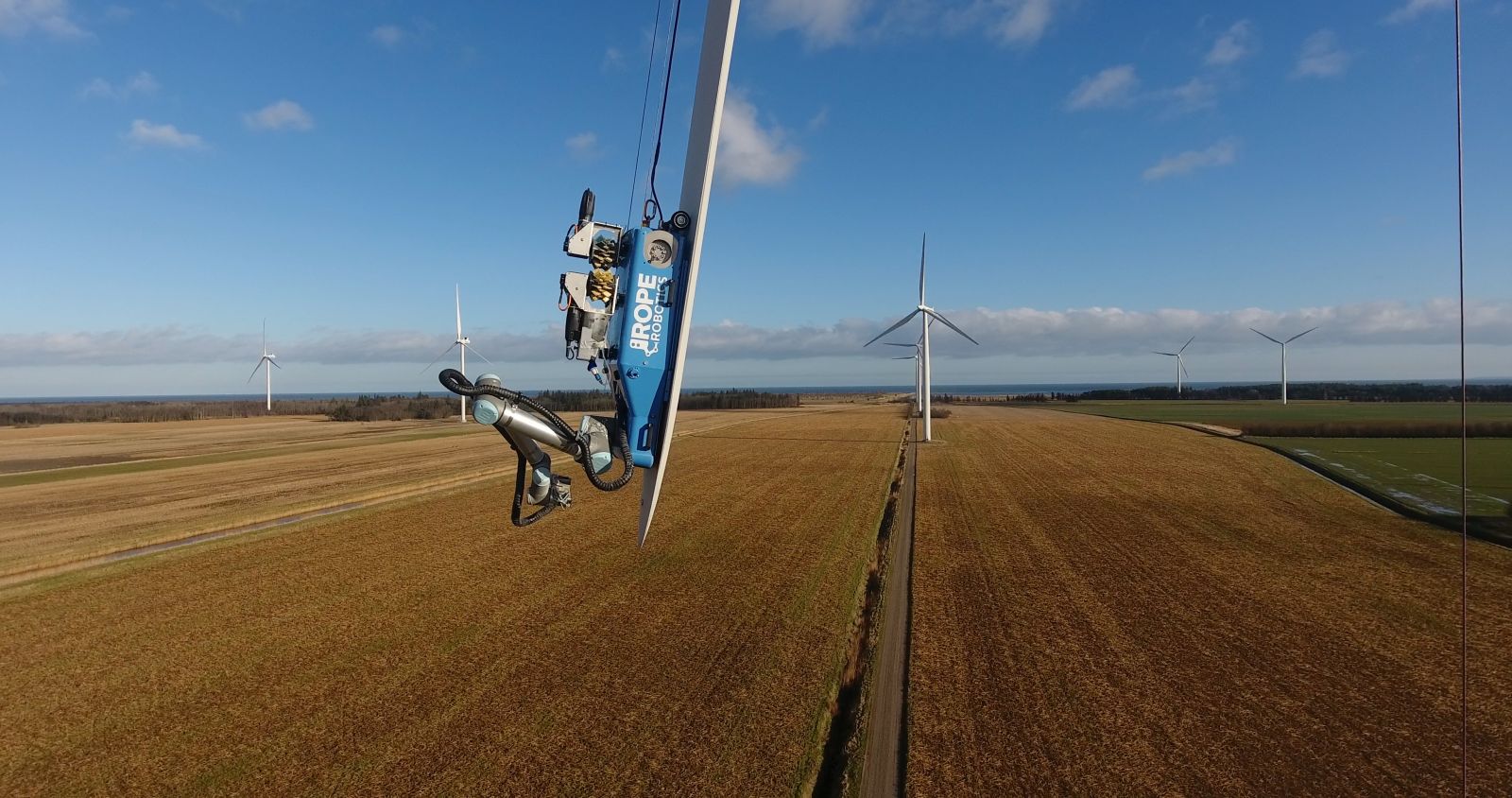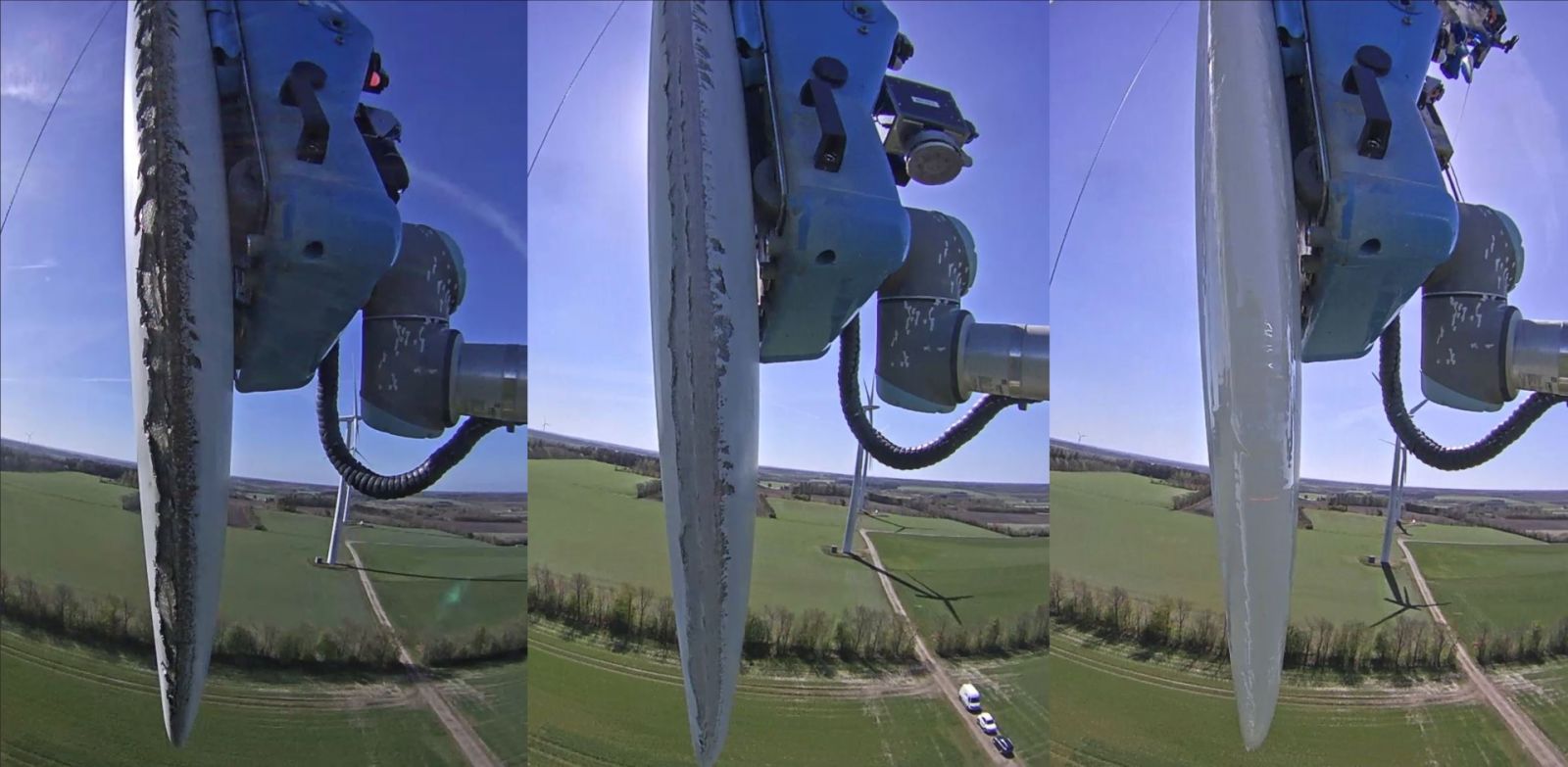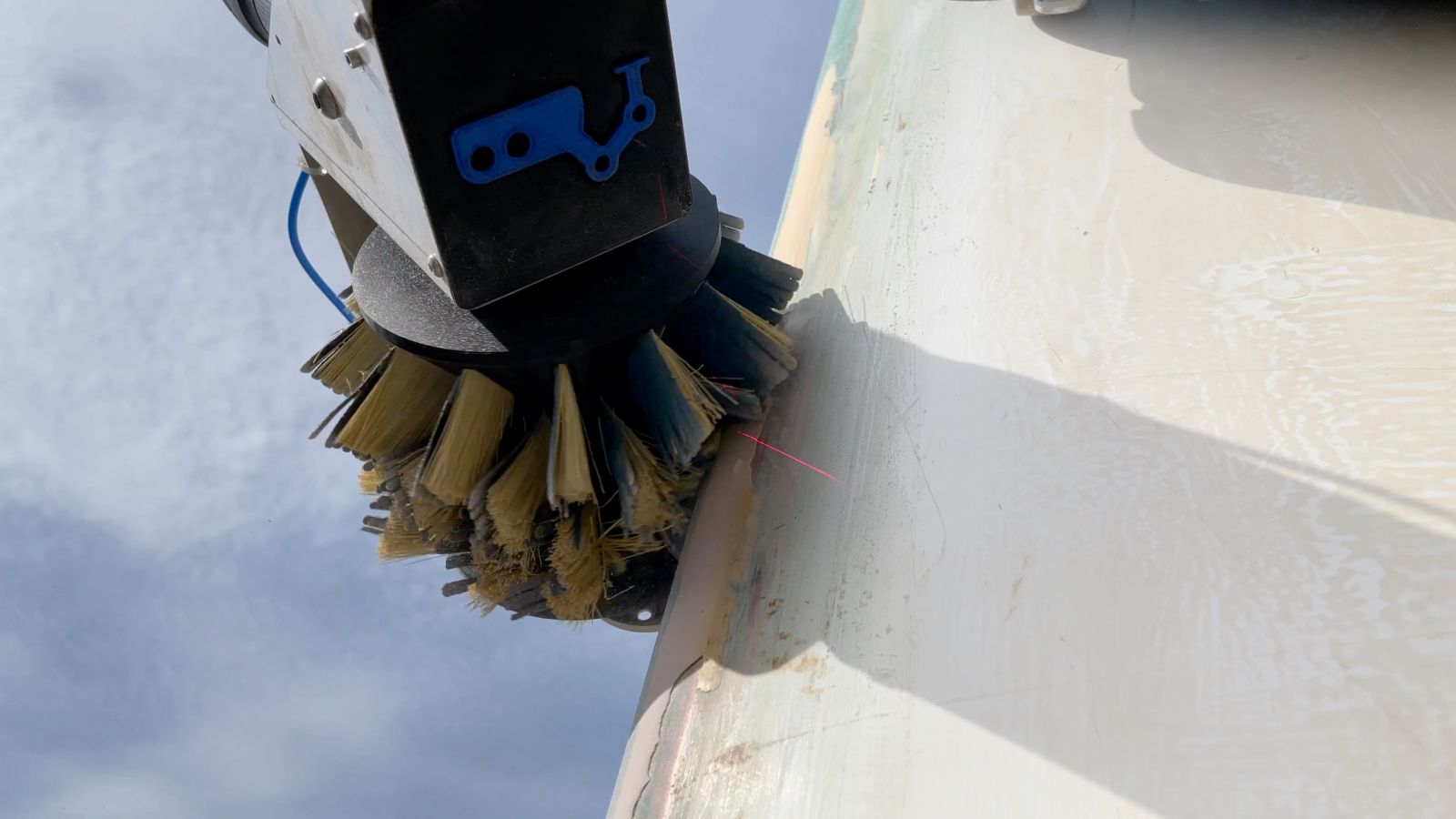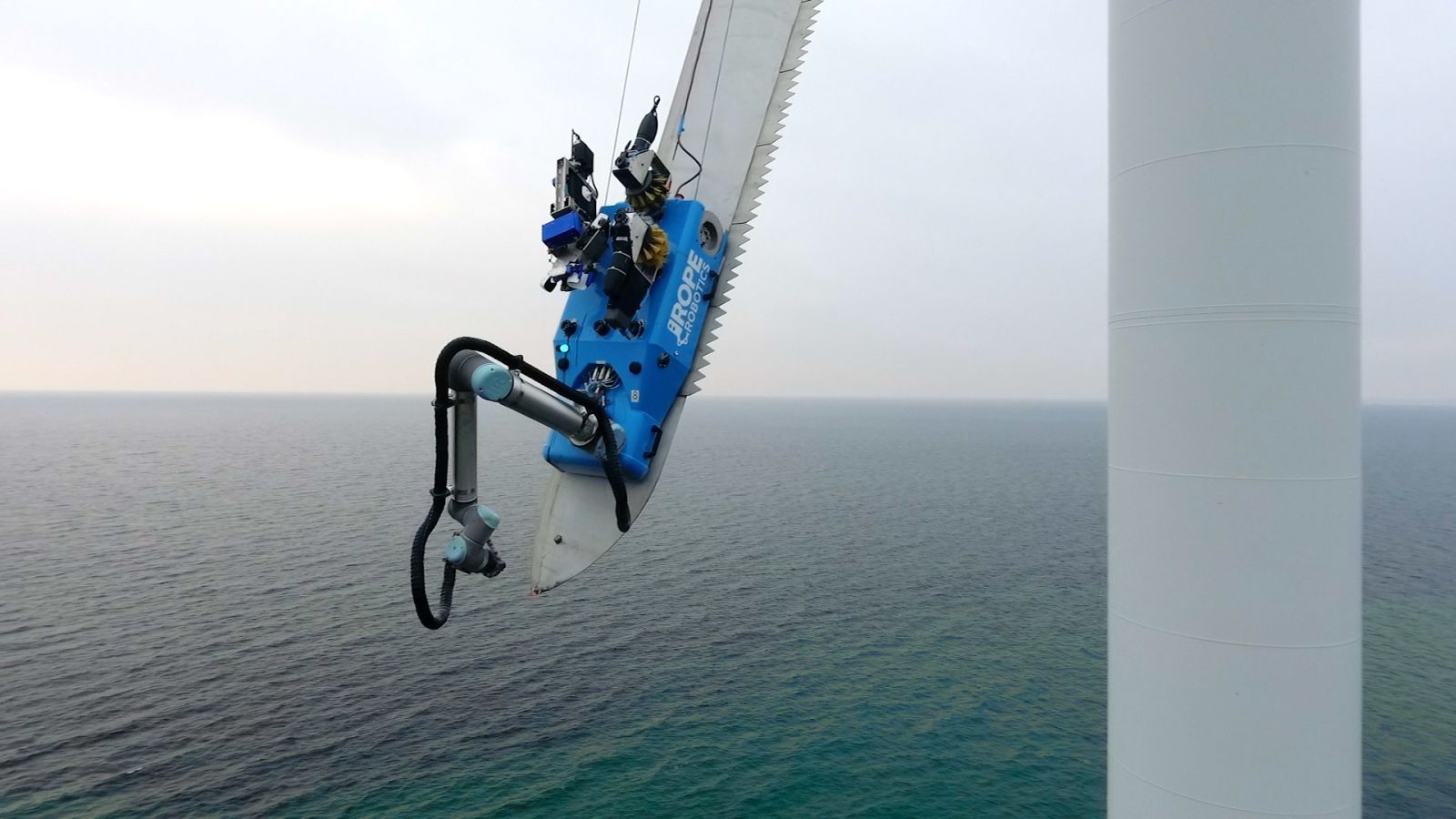Robots Tackle Blade Repair
When a wind turbine blade rotates, the tip can move at up to 200 mph. As rain drops hit the blade, the surface erodes, which reduces the turbine’s ability to produce green energy. Efficient leading-edge repair is necessary to restore the aerodynamic performance of the blade. It also contributes to life extension of one of the most expensive components on a wind turbine: blades. Turbine blades account for some 25 to 30 percent of the build cost.
With more than 400,000 wind turbines in the world, and many more to come, the need for regular maintenance for this problem will increase exponentially.
Blade damage caused by rain erosion is forecast to become an even bigger maintenance problem, as more wind turbines with longer blades and correspondingly higher tip speeds are introduced. New offshore turbines, being even larger, more remote, and more exposed to the weather than onshore, will be a particular challenge.
Repairs of the blade’s “leading edge” - the blade area affected by rain erosion - are dependent on favorable weather conditions. These repairs are complex to perform, requiring skilled, sometimes hazardous manual work hundreds of feet above the ground, often by technicians hanging from ropes. With these specialized repair skills increasingly in short supply, the wind turbine maintenance industry is looking for automated alternatives to solve the problem.

Carrying all necessary tools and supplies, the robot repairs blade
Amid backlog of repairs, robots can add capacity
Currently, there are only a handful of robots on the market capable of restoring the leading edge of the blade. One solution, developed in Scandinavia, now comprises nine robot clones that have been proven in the field over nearly two years on wind farms in North America, South Africa, and Europe. The robots work precisely and consistently, four times faster and at half the cost of the manual alternative. These repairs restore aerodynamic performance up to 3 percent; within six months, the investment made by the turbine owner in the repair service has usually paid off.
The robot can repair not only the challenging leading-edge of the blade, but also standard fixes like repositioning the vortex generator, as well as inspection of the blade structure, drain holes, and lightning receptors.
Wind farms in the US and Canada have taken advantage of this robot solution to help address a backlog of repairs. The robot adds an additional capacity to the market.
The core of the Scandinavian robot system is a climbing robot equipped with a high-resolution camera and laser scanner. The system is also equipped with up to eight repair tools that are operated precisely by a flexible arm. A technician is needed to monitor the robot on-screen, which can be done from any location.

(L) Before repair (M) After cleaning and sanding (R) After final coating
Lightweight robot hoisted by ropes and gripping blade with vacuum system
Transported to the site in a minivan, the (relatively lightweight) 330-pound robot is attached to ropes that have been anchored in the nacelle. It’s then hoisted some 300 feet or more from the ground onto the blade, which has been parked in a vertical position.
A vacuum system allows the robot to attach itself firmly to the blade. Several motors enable it to move across the blade, either up or down. Using its onboard high-resolution camera and laser scanner, the robot first inspects the surface, sending 3D images to the remote operator, who diagnoses the damage on screen and initiates the repair process.

The sanding process prepares the leading edge for rebuilding
Sanding, cleaning, and restoring blade in seven hours
The repair process of the damaged area starts using the 10lb sander tool, applying appropriate speed and force to create a pattern to ensure surface roughness and geometry. The area is cleaned using the brush along with a cleaning solution to remove dirt. A dosing tool then applies the leading-edge protective (LEP) material, while a spreader tool rebuilds the optimal aerodynamic blade shape, smoothing the material to pre-defined standards. The robot moves vertically up the blade edge until all repairs are complete. The whole process (conducted at height of 150-300 feet), takes from five to ten hours to complete.
Images are recorded, serving as documentation to conform with the global requirement for wind turbine maintenance. These images are archived as part of the process, ensuring authentic documentation, which is an advantage for transparent traceability.
Application and dosing of viscous material
The biggest challenge in building a functioning robot was the development of the spreader and dosing tools that can apply viscous material accurately and flexibly across different blade types. The tools match or exceed the manual standards, and were designed to work in a wide environmental window.

Offshore Robot performing leading edge repair near blade tip
Extended weather window and AI
The robot has been proven in the field at high wind speeds of up to 31 mph per second for up to 10 minutes at a time. The robot can withstand gusts of wind of over 33 mph meters per second, relative humidity of up to 80 percent, and temperatures from 32 to 104 degrees Fahrenheit.
Using Artificial Intelligence, the next generation of robots will become even more autonomous. The detailed logs from the hundreds of repairs already carried out will be used to train the robot to recognize and treat the damage without supervision. In addition, a robot capable of offshore repairs will be launched, once reliability tests have been conducted in this demanding environment.
Robot-assisted (and future autonomous) repairs will make a significant contribution to wind turbines competitiveness through decreased maintenance costs, both onshore and offshore.
Martin Huus Bjerge is the CEO and co-founder of Rope Robotics, a Danish automation company that specializes in service tasks for the wind energy sector. Coming from an electrical engineering background, Martin has worked for 16 years in the wind turbine industry on turbine control systems, big data and analytics, and robots and automation. Martin previously worked as a department manager at Siemens Gamesa, where he was responsible for data collection and analytical monitoring of the entire fleet in service. Martin owns 15 patents, two of which are for the world’s first leading-edge blade-repair robot, in commercial operation since spring 2021.
Rope Robotics | roperobotics.com
Author: Martin Huus Bjerge
Volume: 2023 March/April








